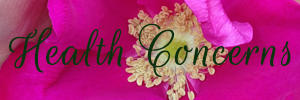It’s easier and more beautiful than you’d expect! ~
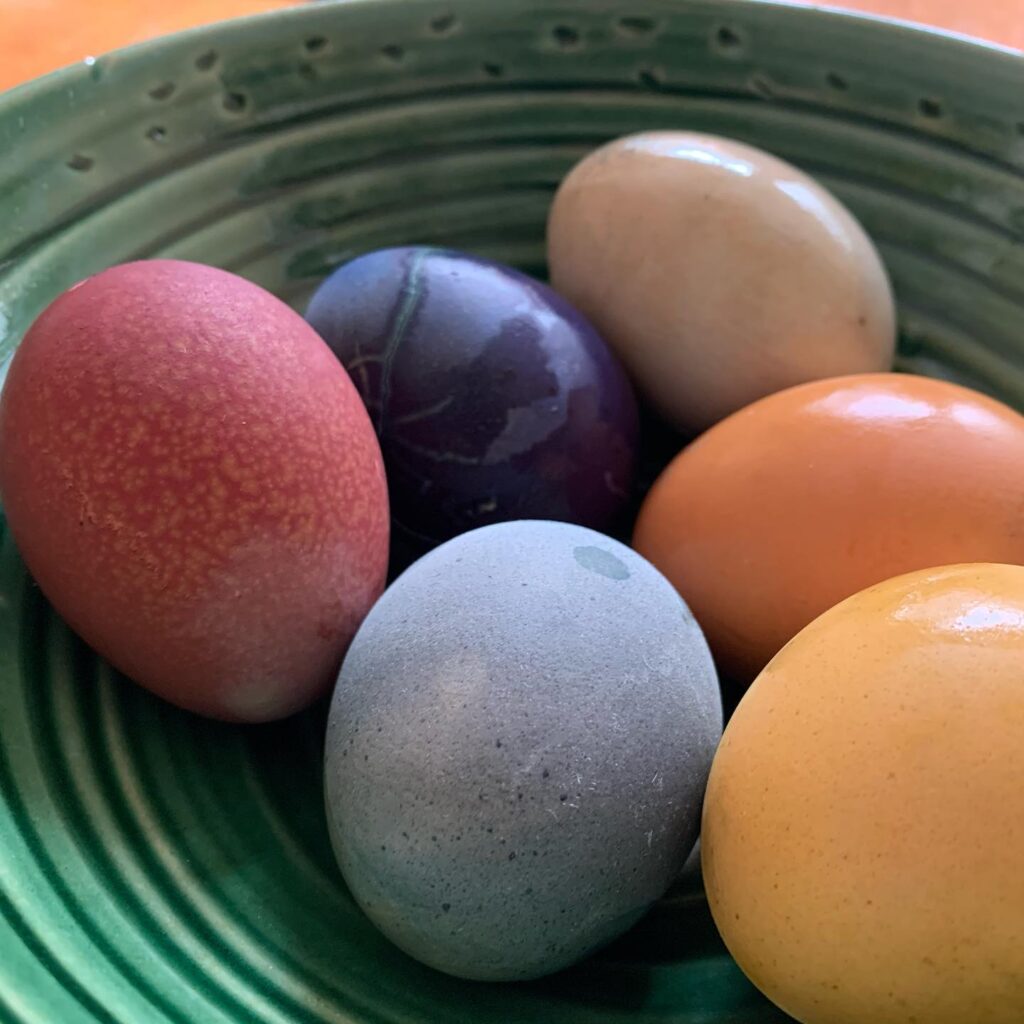
A Little Easter History & Springtime Tradition
Dyeing eggs is a popular Easter tradition within Christian culture. Yet, this and many of our Easter rituals pre-date Christianity and have more to do with spring than Christ. These first eggs of the year symbolize a new beginning, birth or rebirth, the start of spring, and the rebirth of the sun and longer days after winter’s darkness. Historians believe that dyeing eggs originated in Germanic cultures alongside the April celebration in honor of the spring goddess Ostara (also named Ēostre, or Easter, the namesake of the celebration). As Christianity swept across Europe, these traditions transformed to celebrate Jesus Christ’s miraculous resurrection and the rebirth of the Son, folding into pre-existing Easter celebrations.
Dyeing eggs is a perfect activity to do with kiddos, but even adults without children can enjoy this simple craft. I’ll admit, I grew up using artificial dyes and was skeptical that plants could come close to their cheery colors, and I assumed a lot of extra work was involved. Turns out, I was wrong. Although natural dyes take longer to develop on the eggs, the active prep time is not much different, and you likely have many of the ingredients already in your kitchen.
After a variety of trial runs, I’ve come up with a selection of plants that make the most impressive colors with the least amount of effort.
Gather and Hard Boil Your Eggs
White eggs will best show off the color of your natural dyes, but brown eggs work, too! This is welcome news to those of us with backyard flocks or who buy from local farms that only sell brown eggs. Dyes will show up brighter and more nuanced on white eggs, whereas brown dyed eggs will have earthier, orange-tinged (but still lovely) hues. In my test runs, most natural dyes looked nice on either color eggs, but a few – mainly hibiscus and purple cabbage – were drastically prettier on white eggs versus brown.
If possible, buy your eggs a week or two before you boil them – once hard boiled, they’ll peel more easily than than fresh eggs. Backyard and farm stand eggs are so fresh, they’ll need more time to age in the fridge than those from the grocery store. If you forgot to allow time to age your eggs, that’s ok – you can still dye them, they just won’t peel as easily.
Why Are Some Eggs White and Others Brown?
White eggs are generally laid by chickens with white earlobes, particularly Leghorns as well as some other less common breeds. Chickens with red earlobes generally lay brown eggs, including most of our popular backyard and farmstead breeds including Orpingtons, Rhode Island Reds, most Sex Links, Golden Comet, and Barred Rocks. (Some specialty breeds lay blue/teal, olive, and dark brown eggs.) The color of the eggs doesn’t necessarily indicate nutritional value or how local or fresh the eggs are – simply the breed of chicken that made them. However, many local farms to opt for brown egg hens while factory farms tend to favor white egg layers. Nutritionally, if everything else was equal, white and brown eggs are identical. However, chickens raised naturally with access to pasture and sun will lay more nutritious eggs than those raised entirely indoors in stressed environments. Specifically, tests have found that pasture-raised backyard chickens laid eggs that had 25 percent more vitamin E, 75 percent more beta carotene, 20 times more omega 3 fatty acids, and half the cholesterol of a factory farmed egg.[1] And, of course, the chickens themselves live happier, more humane lives.
There are a variety of methods available to hard boil eggs – boiling, steaming, or in the Instant Pot. Try steaming eggs in a basket with about 1-inch of water for approximately 15 minutes, drain, cover with cold water and ice to cool. (Or Google other methods.) Check an egg to make sure it’s cooked to your liking.
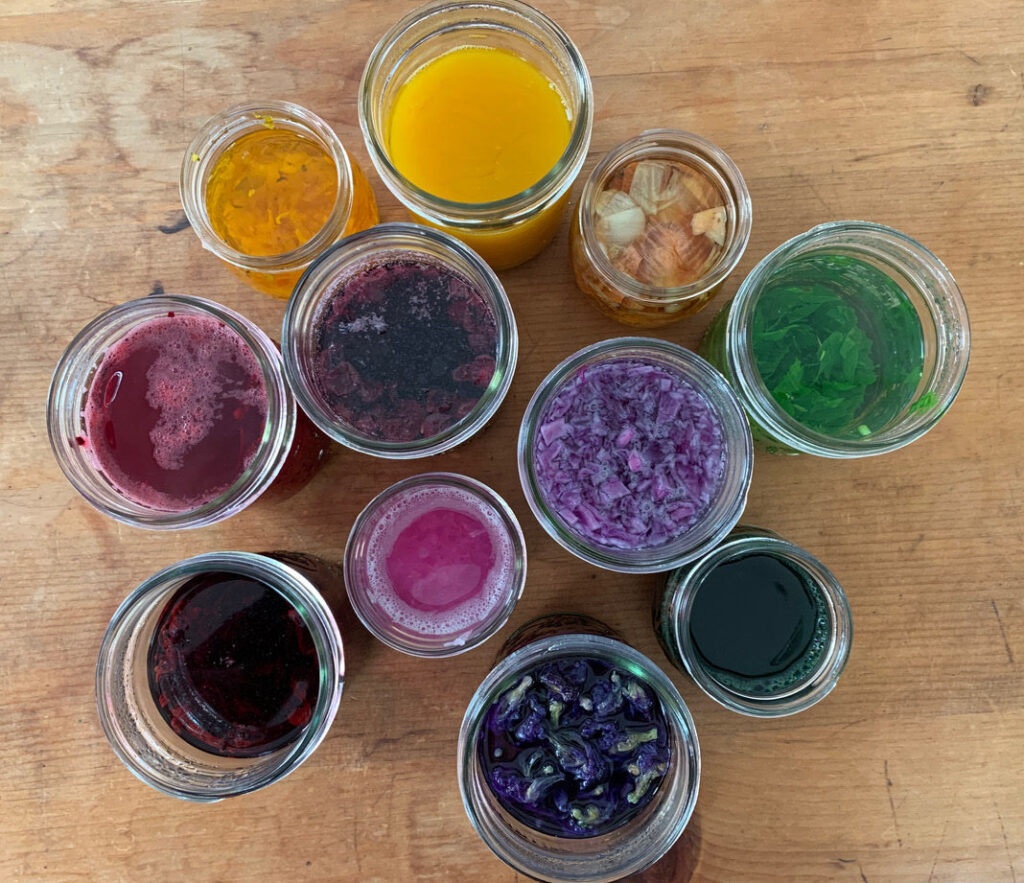
Prep Your Dye
I prefer to work with dye plants that don’t require simmering to extract the color to keep it simple. Simply make a strong tea by covering the dried herb or fresh prepped veggies for 30 to 60 minutes. (*Blueberries are the exception – simmer for 10 minutes. They impart a somewhat similar color as butterfly blue pea flowers.) Here are some of my favorites:
| Dye Plant Options | Egg Color | Brown or White Eggs | Quantity per 2 cups hot water (multiply or divide as needed) |
| Red Beets | Pink to Red | either | 1 beet or about ½ cup, fresh grated |
| Turmeric | Yellow | either | 1-2 heaping teaspoons dried powder |
| Hibiscus | Dark Teal Green or Midnight Blue | white | 1-2 heaping teaspoons dried flowers (try a shorter steep time) |
| Purple Cabbage | Teal-Blue | better with white | ½ cup fresh grated or finely chopped (try a longer steep time) |
| Butterfly blue pea flower | Blue to Purple-Blue | either | 1-2 heaping teaspoons dried flowers |
| Blueberries | Slate Blue | either | *Gently simmer ½ cup frozen blueberries |
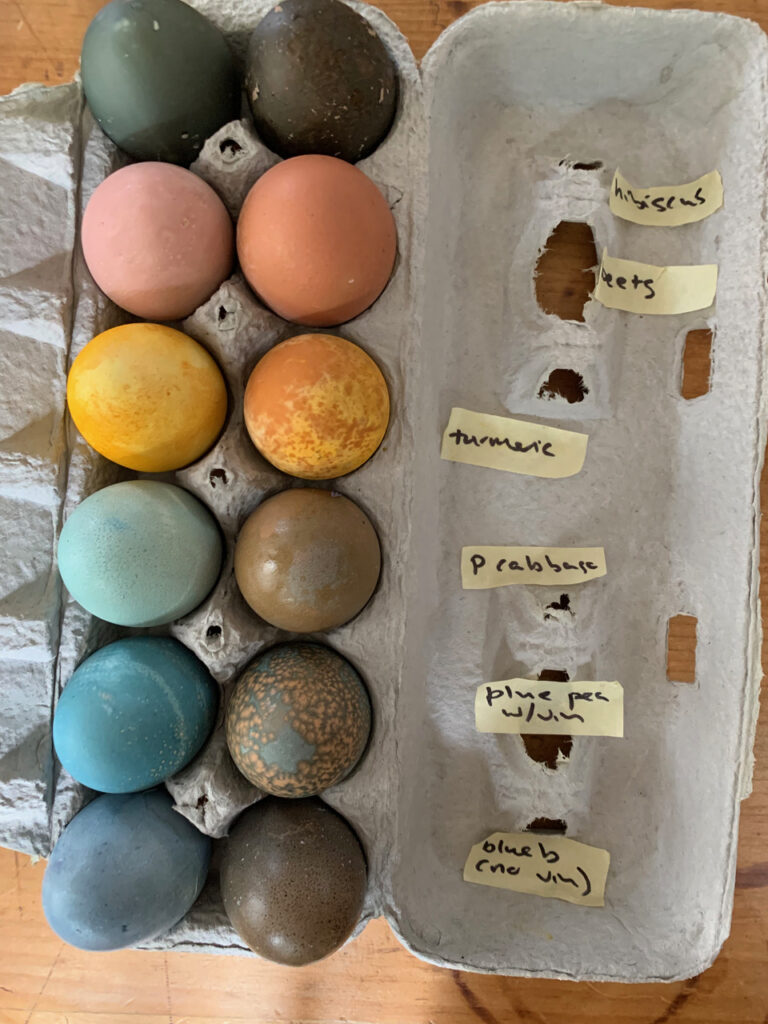
These are “the best” of my official test run. On the left are those made with store-bought white eggs versus the ones on the right made with my chickens’ brown eggs. You can see how certain colors really shine on a white egg.
Strain, Add Vinegar:
Once you’ve steeped your tea for 30 to 60 minutes, strain them out and pour into glass containers. Full confession – I don’t usually bother straining and just pop my eggs in with the dye plants, but they will dye more evenly in a strained dye bath. (Leave at least 2 ounces worth of head space in the jar per egg so you don’t overflow when the eggs are added). Add a splash of vinegar (about 2 teaspoons per cup of dye bath), and pop in your eggs. Mason jars work great for this: 8-ounce jelly jar works for 1 egg or 16-ounce pint jar for 2 eggs.
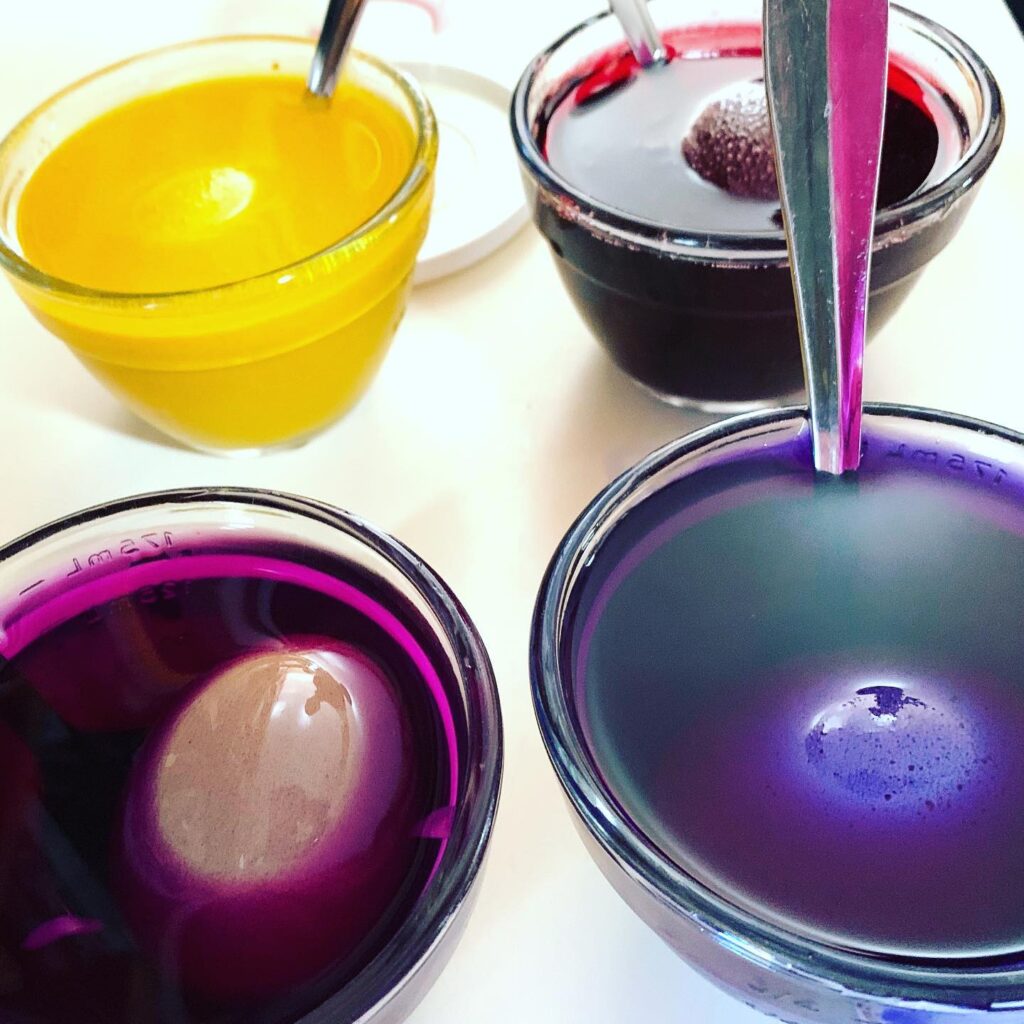
Ok, plant nerds, here’s some fun food chemistry for you!
- Calcium carbonate in eggshells is naturally alkaline. Shells become more alkaline as eggs ages and become less fresh, which also makes them easier to peel. If your egg hasn’t been washed and has a still has its protective “bloom” on it, it doesn’t age as quickly.
- We add vinegar to the dye bath as a mordant to soften the eggshell and help the colors stick. The acid-alkaline reaction of the vinegar on your eggshell may also cause small carbon dioxide bubbles to form on your egg surface and a scummy surface on the top of the dye bath.
- Washing the “bloom” off each egg beforehand will also improve the dye’s ability to stick to the shell. I’ve never done this, but I can see how it would improve the outcome. The bloom sometimes turn into a flimsy “skin” that slides off or wrinkles on your dyed egg – a particular problem for hibiscus and purple cabbage in my test batches.
- The exact acid-alkaline balance will shift the hue of anthocyanins. In a somewhat neutral pH, they’re blue. More acidic, they’re purple, magenta, pink, or red. More alkaline, more teal. On your eggs, blueberries and butterfly blue pea shift to be blue or purple depending on vinegar acidity. Meanwhile purple cabbage and red hibiscus impart surprising teal green tones when they react with the alkaline eggshell.
Decorate?
If desired, wrap flowers, leaves, or ribbons against your eggs (wrapped with lace or nylons tied with string to hold them in place) before you put them in the dye bath. The dye won’t stick in these spots, creating a stenciled appearance.
Add Eggs, Steep in Fridge
Gently drop your eggs in the jars, cover, and put in the refrigerator. The longer they sit, the deeper the color will be, with the most vibrant in a 12-24 hour time period. (If you’re aiming for pastel tones from a short steep, they’ll be more obvious on a white egg.) Check them periodically – some like hibiscus might look nicer after shorter time frames.
Final Steps:
When the colors reach your desired hue, gently remove from the dye bath with a spoon and let air dry on a paper towel or baking rack. Don’t rub them dry – this might remove the color! Some colors shift as they dry. Once they’re done, they’re ready to put on display and enjoy for food. If desired, once totally dry, gently rub with a little vegetable oil to make them shiny and more vibrant. (I prefer the oil-free matte appearance.) Dyed hard boiled eggs keep in the fridge for at least one week.
Additional Colors to Try?
Onion skins or coffee make a coppery yellow-orange-brown color, but they’re best simmered and the outcome might look just like a regular brown egg. Try red onion skins for a deeper shade. (Onion skins are classic for dyeing eggs in Greek Easter traditions.)
I’ve seen lovely parsley– and spinach-dyed green eggs online, but my test runs did NOT turn out well; they’re probably best simmered?
Paprika creates orangey-red shades.
You can also combine dyes – turmeric plus beets for an orange egg; turmeric plus purple cabbage for green.
What Are Butterfly Blue Pea Flowers?
Butterfly Blue Pea Flowers (Clitoria ternatea) from Thailand are emerging as a fun tea and food colorant. The plant is in the pea family, and the flowers are deep blue-purple, rich in anthocyanins (much like blueberries). The flowers don’t taste like much of anything – mildly like pea shoots – but they create stunning colors for tea and food. Plain water extracts blue tones. Adding an acidic ingredient like vinegar or lemon turns it magenta or purple. More alkaline ingredients (like nettle or baking soda) make it more teal-toned. Most herb suppliers don’t carry butterfly blue pea flowers yet, but you’ll find them at specialty tea companies and online. You can also buy seeds to grow and harvest flowers as an annual, even in cooler climates. I haven’t grown them yet, but I met a family in Pennsylvania that said they got fantastic flower harvests, and you can find seeds online. You can also use the dried flowers to dye vodka for fancy cocktails, add the colorful tea to the cooking water of white rice to turn it blue, sprinkle into hibiscus and berry-flavored teas for added color vibrance, etc. Regular use likely promotes vascular, nerve, and brain wellbeing much like the same pigments do in blueberries. It’s purported to have relaxing and anti-stress effects, though I haven’t noticed any dramatic effects personally from the flowers (most research used roots and aerial parts). You can certainly attain similar egg dye colors from plain ol’ frozen blueberries, but butterfly blue pea flowers are fun to play with in the kitchen.
Maria’s Quick Egg Salad Recipe
Mash up 1 egg with a large dollop of mayonnaise and a smidge of yellow mustard with an optional sprinkle of salt and pepper – simple and delicious!
Clinical herbalist Maria Noël Groves sees clients and teaches classes at Wintergreen Botanicals Herbal Clinic & Education Center in Allenstown, New Hampshire.
The statements made on this blog have not been evaluated by the FDA and are not intended to diagnose, prescribe, recommend, treat, cure, or offer medical advice. Please see your health care practitioner for help regarding choices and to avoid herb-drug interactions.
This article originally appeared in Herb Quarterly magazine.
[1] https://www.motherearthnews.com/homesteading-and-livestock/benefits-of-backyard-eggs



